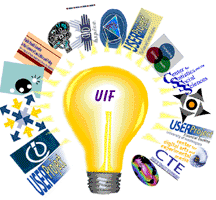
 |
UNIVERSITY INITIATIVES FUND (UIF)
|
All UIF proposals must promise significant academic impact, or provide substantially enhanced level of service to academic programs, advance quality and excellence, and provide for long-term significance and sustainability. Beyond this, additional considerations are those that position the University to become a leader in a field; initiatives that emphasize areas in which the University has comparative advantages; initiatives that can benefit from special leverage; initiatives that recognize the University's unique role in the state, region, and beyond; initiatives that respond to significant public issues of our region and time; initiatives that foster cooperation and collaboration between and across multiple units; initiatives that improve productivity; and initiatives that transform the work environment in significant ways.
The range of projects has been inspiring, from a Center for Nanotechnology to a Center for Digital and Experimental Arts; from an undergraduate program in Neurobiology to a graduate program in Biomedical and Health Informatics; from an administrative services project to vastly improve efficiencies in payroll to one that improves Grant and Contract Services. The list goes on, and has brought a great sense of the possible to the community.
The UIF addresses these problems by instituting mechanisms both for the tax on existing resources and the reallocation to cutting-edge programs. Money for the fund comes from an assessment on all University operating budgets, amounting to approximately $8 million each biennium. Competition for these funds includes review and recommendations by a University-level committee made up of top faculty and staff. Final decisions for funding are made by the Provost and the President.
In analyzing their impact, the most important question is whether these initiatives contribute to key priorities of the University. If the UIF merely inspired wonderful new programs, but had no relationship to University priorities, the UIF would fall short of its intended purpose.
Furthermore, the accomplishments of the UIF projects are measured against the uses to which the money would have been put if there had been no tax. The assessment of the cuts is as important, in this regard, as the assessment of the projects. In any reallocation mechanism, there must be benefit derived from the strategic planning that goes into the cuts, as painful as they are, as well as from the allocations that result. In order to realize that benefit, the consequences of those cuts must be as well-analyzed and as transparent as the accomplishments of the new projects. Without that, the comparison of the use of the funds cannot take place. Although this is well-recognized, few reallocation projects take seriously the analysis of the so-called "dark side", preferring instead to downplay it. We have not done that at the UW, and have benefited from the tough standards that have resulted.
Interestingly, the ambitions of UIF projects often are very much linked to public purpose. Consider, for instance, PRISM, which provides for a very advanced holistic modeling capacity for the environmental system of Puget Sound. The benefits to regional and State planners have been immense, and, indeed, the project is not only the best in its class from a disciplinary point of view, as judged by outside reviewers, it has also made an unparalleled contribution to this state. On a broader scale, consider Public Health Genetics, drawing on faculty and student expertise from public health, law, public affairs, medicine, and social sciences. Their intensive multidisciplinary research has won them not only acclaim in their fields, but also the attention (and dollars) of the Center for Disease Control (CDC). The real beneficiaries in many of these awards are, therefore, the unnamed members of the public.
The UIF is theoretically replicable in all State universities, as well as private ones. Indeed, there is evidence that at least 11 universities have tried something similar with much less success. The UW's success in implementation, relative to other universities, should be quite instructive.
It should be noted that the UIF has been thoroughly evaluated. First, each individual project is evaluated in its fourth year. The nine projects from the first round were evaluated in 2001, and two were discontinued as a result. Even though those two were making a positive contribution, they did not measure up to the high bar of the UIF. Additionally, in 2001, the UIF as a whole was reviewed by a team drawn from inside and outside the UW, including such dignitaries as Rita Colwell, Director of the NSF, and James Faulstich, a member of the Higher Education Coordinating Board in the State of Washington. These reviews are helpful to the UW in going forward, but would also be instructive to any university or college interested in pursuing a similar path. All reviews are available on the web.